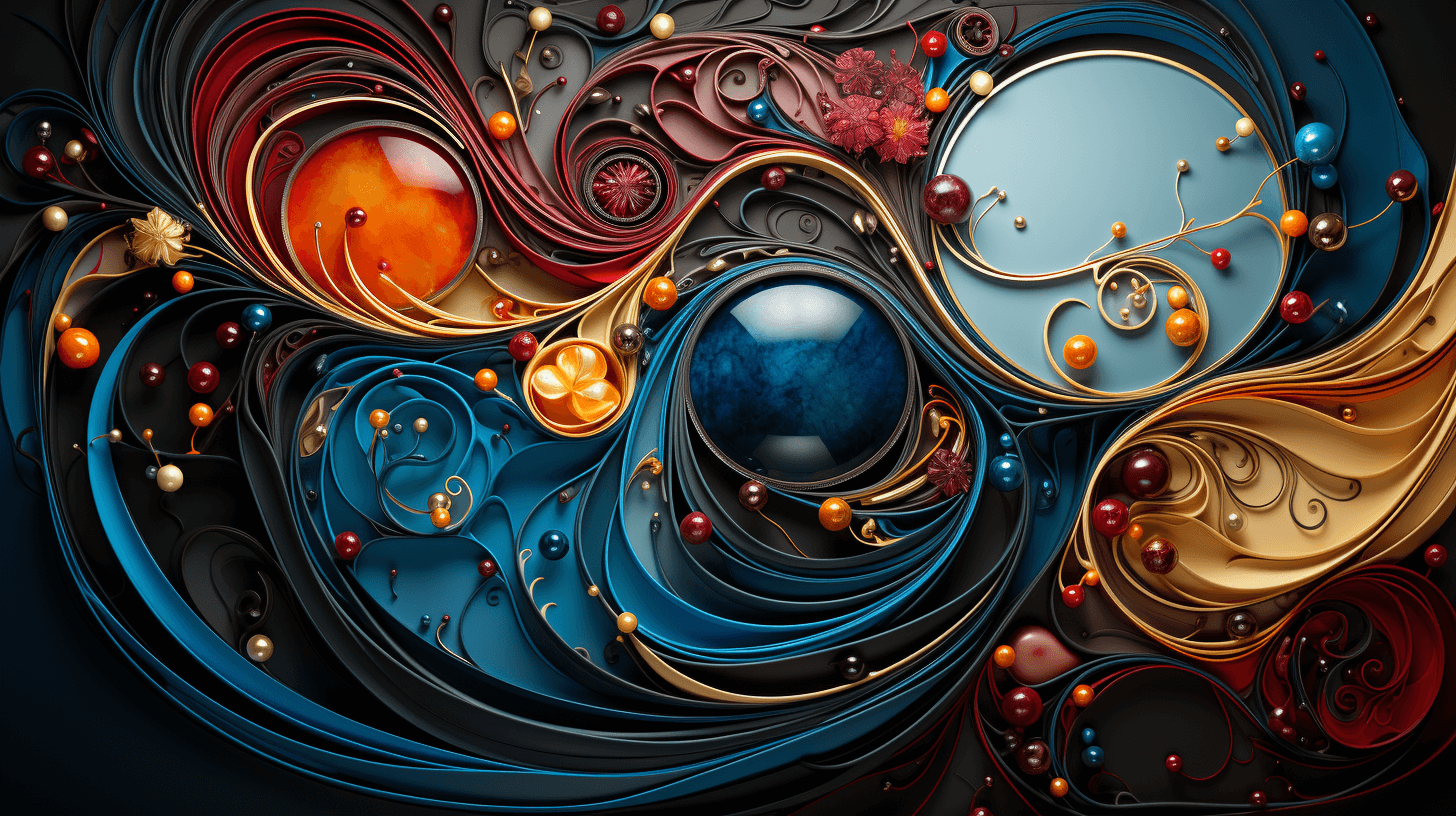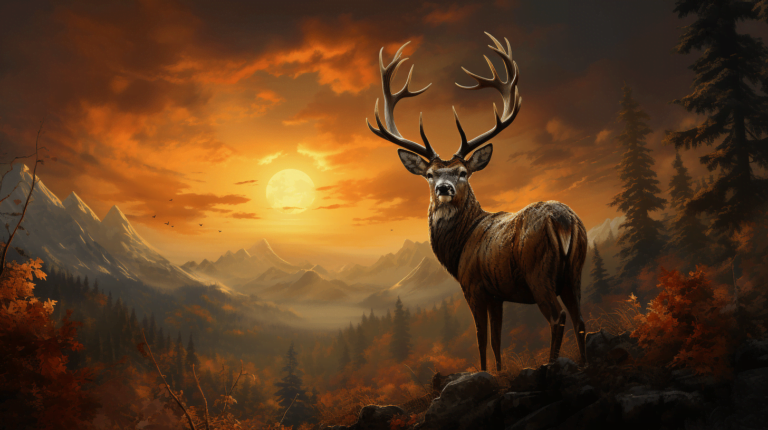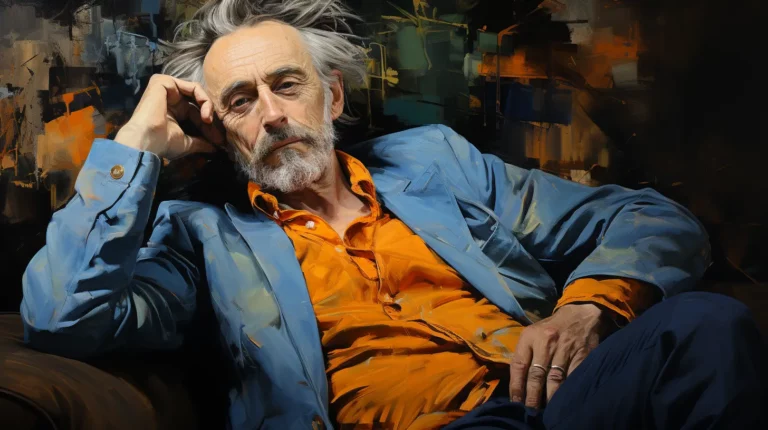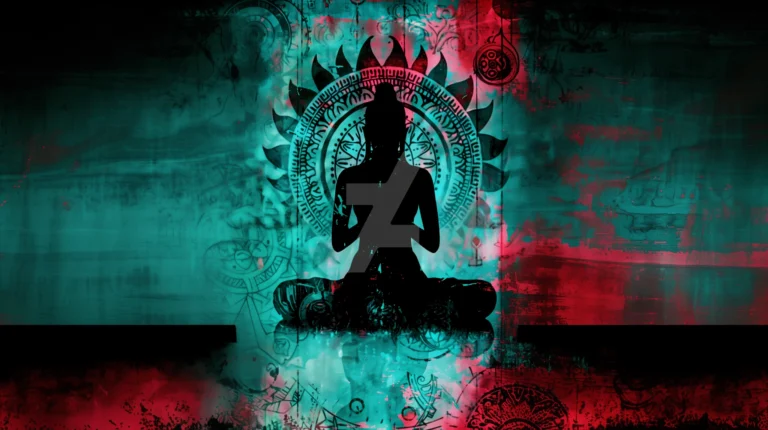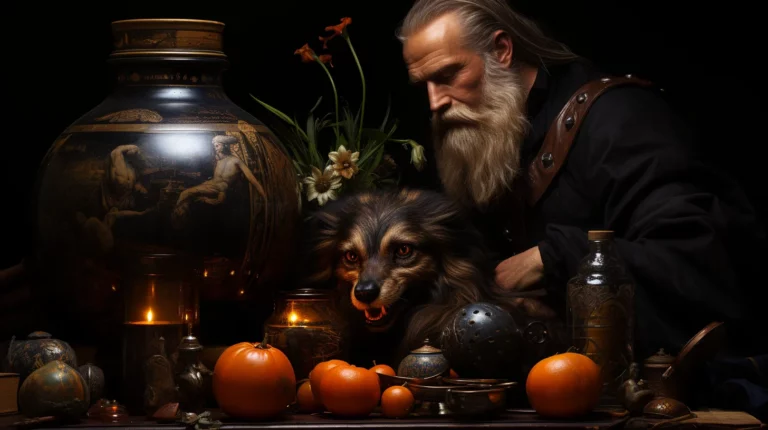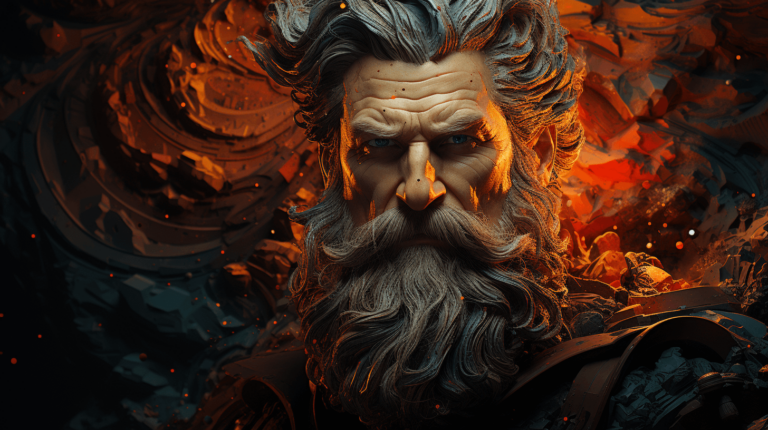Mythological Themes
Mythological themes form the bedrock of cultural storytelling, shaping the narratives that societies have used for millennia to understand the world around them and their place within it.
Spanning across various cultures and eras, these themes offer universal insights into the human experience, exploring profound questions and concerns shared across the breadth of humanity.
From creation and destruction to heroism and trickery, from divine intervention to the mysteries of death and the afterlife, mythological themes illuminate the complexities of life, the cosmos, and the human psyche.
They are the threads that weave together the intricate tapestry of myths, offering a lens to delve into our shared history, our collective subconscious, and our enduring quest for meaning.
Creation Myths
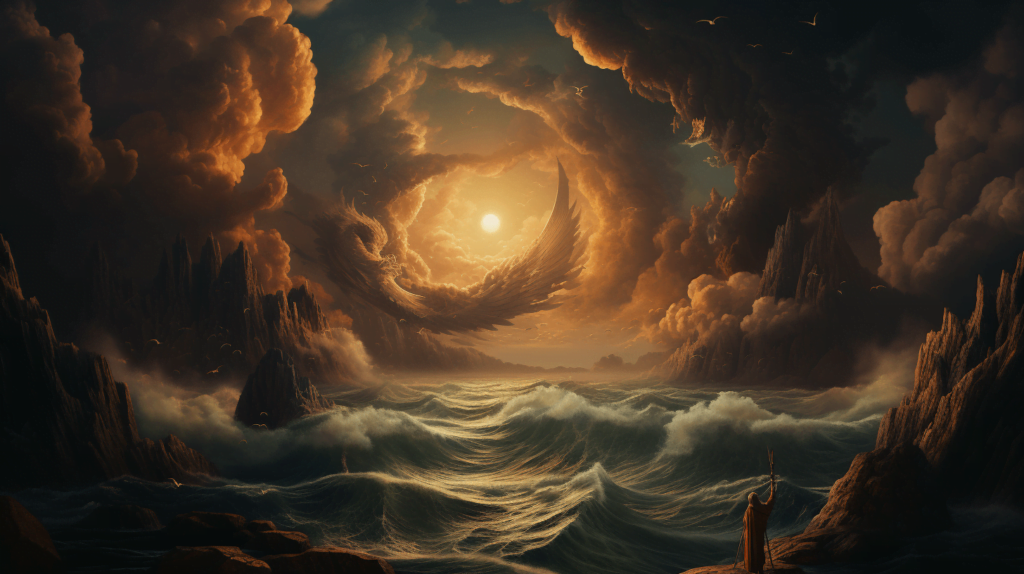
What was there before the universe? How did life come into being? Such fundamental questions have long occupied human thought, sparking the birth of creation myths. These narratives, fashioned from the cultural loom of various societies, attempt to explain the origins of the universe, the Earth, and life itself. This section offers a beginner-friendly guide to understanding the nature, purpose, and variations of creation myths across the world.
Understanding Creation Myths
Creation myths, also known as cosmogonic myths, are traditional narratives that describe the origins of the cosmos. They often involve supernatural beings, deities, or primordial forces and serve as a society’s explanation for the mysteries of existence. The stories usually encompass the creation of the universe, the Earth, all living creatures, and humans.
Functions of Creation Myths
Creation myths serve several key functions in societies:
1. Explanation: They offer an answer to existential questions about the origins of the universe and life, providing a framework for understanding the world around us.
2. Cultural Identity: These myths reflect the values, beliefs, and traditions of a society, helping to shape its collective identity.
3. Social Order: They often establish societal hierarchies and norms, setting the stage for social order and organization.
4. Spiritual and Religious Foundation: Creation myths form the bedrock of many religious beliefs and rituals, connecting the physical world with the spiritual realm.
5. Moral Lessons: They impart moral lessons and norms, often portraying the consequences of transgressing divine or natural laws.
Variations of Creation Myths
Despite the cultural diversity of creation myths, some common themes can be observed:
1. Ex Nihilo (Out of Nothing): In these myths, the universe is created out of nothing, often by a deity or divine entity. An example is found in the Book of Genesis in the Bible, where God creates the world and all its inhabitants in six days.
2. Chaos or World Parent: These myths suggest the universe was born from chaos or from cosmic parents. In Greek mythology, for instance, the world emerged from the void of Chaos. In the Maori tradition of New Zealand, the primal parents, Rangi (sky) and Papa (earth), were separated to create the world.
3. Emergence: In these myths, life begins in a subterranean world, and beings emerge to the surface through a journey or transformation. This is seen in certain Native American traditions.
4. Earth Diver: In these stories, the world is created from the primordial ocean after a creature dives to bring up earth or mud. This theme is common in certain Native American and Siberian cultures.
5. Cosmic Egg or Embryo: These myths depict the universe or life being born from a cosmic egg or embryo. A well-known example is the Hindu myth of Brahma emerging from a golden egg to create the world.
Conclusion
Creation myths, in their captivating array of forms and narratives, offer a fascinating lens through which to view our shared human experience. They embody our ancestors’ earliest attempts to grapple with the mysteries of existence, giving shape to the ineffable and turning the chaos of creation into a story we can comprehend and share. As we explore these narratives, we don’t just learn about the universe’s imagined origins – we uncover the human impulse for storytelling, explanation, and the quest for meaning.
Myths of Gods and Goddesses
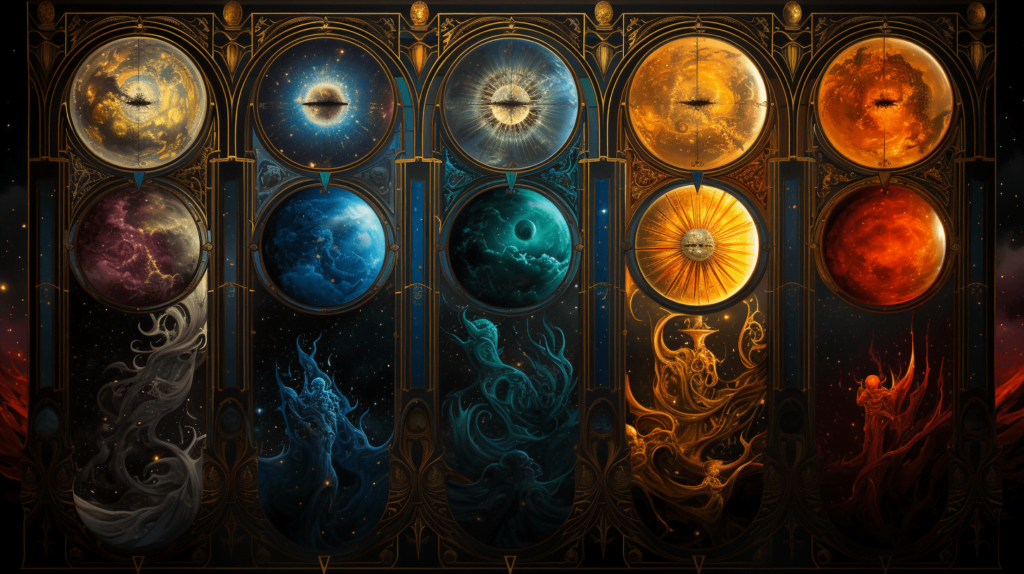
The narratives of gods and goddesses form the vibrant heart of many mythologies across the globe. These immortal beings, equipped with divine powers and often depicted as having human-like traits, serve as central figures in a vast array of mythical tales. Their stories reveal the ancients’ attempts to understand the world, codify morality, and explore the very essence of human nature. This section aims to offer beginners an introduction to the myths of gods and goddesses, providing an overview of their roles, significance, and the lessons they impart.
Gods and Goddesses in Mythology
In the sphere of mythology, gods and goddesses occupy the highest echelons of the supernatural world. They represent various aspects of life, nature, and human experiences. Gods of thunder, harvest, war, love, wisdom, death, and countless other domains can be found in various mythologies, each with their unique narratives and characteristics.
Functions and Roles of Gods and Goddesses
1. Creators and Destroyers: Many gods and goddesses are known for their creative or destructive roles. In many creation myths, gods are the architects of the universe, Earth, and life itself. Conversely, there are also deities associated with destruction and death, maintaining the balance of the cosmic order.
2. Guardians and Patrons: Certain deities serve as protectors of specific places, people, or concepts. Athena, in Greek mythology, is the patron goddess of Athens and the guardian of wisdom and strategic warfare.
3. Teachers and Moral Guides: Deities often impart wisdom, knowledge, and moral lessons to humans, either directly or indirectly. Their stories serve as narratives that highlight virtues and discourage immoral behavior.
4. Protagonists in Myths: Gods and goddesses often play central roles in myths, involving epic battles, heroic quests, divine rivalries, love stories, and tragedies. These narratives reveal their strengths, weaknesses, virtues, and vices.
Notable Myths of Gods and Goddesses
1. Greek Mythology: Greek mythology is rife with gods and goddesses. For instance, the story of Zeus, the king of the gods, recounts his battle with the Titans, his rule over the cosmos, and his many love affairs.
2. Egyptian Mythology: Ancient Egypt’s pantheon includes gods like Ra, the sun god, and Isis, the goddess of magic and motherhood. The myth of Osiris, Isis, and their wicked brother Set is a fundamental narrative involving death and resurrection.
3. Norse Mythology: The Norse gods, like Odin, Thor, and Loki, feature in a wealth of myths that explore themes of power, honor, deception, and the impending doom of Ragnarok.
4. Hindu Mythology: Hindu mythology presents a complex array of gods and goddesses. The narratives of deities like Vishnu, Shiva, and Durga explore cosmic balance, devotion, and the triumph of good over evil.
Lessons from the Myths of Gods and Goddesses
While the gods and goddesses may seem otherworldly, their myths often mirror human experiences and struggles. They experience love, jealousy, ambition, wrath, and joy, not unlike humans. The tales of gods and goddesses are essentially reflections on humanity, holding up a mirror to our virtues and follies. Through their narratives, we can glean insights about ancient cultures, moral lessons, and timeless wisdom about life, nature, and our place in the universe.
Conclusion
The myths of gods and goddesses, as explored through countless cultures and eras, form a vibrant tapestry of human imagination and inquiry. They function as keys that unlock profound understanding of our ancestors’ worldviews, philosophies, and existential questions. By studying these divine narratives, we do not just engage with stories from the past; we explore the timeless narratives of human experience that continue to echo through the ages.
Heroic Myths
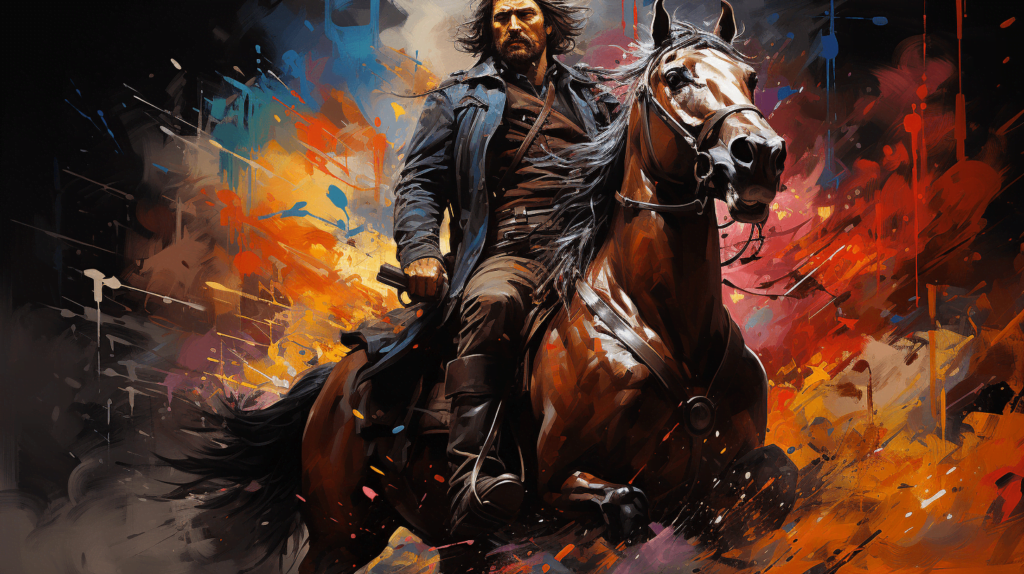
Throughout the annals of mythology, the narratives of heroes and their epic quests have long held a cherished place. These heroic myths, also known as hero myths or hero tales, transcend cultural boundaries, resonating with audiences across ages and continents. They encapsulate the struggle and triumph of individuals who, despite their ordinary beginnings, rise to achieve extraordinary feats. This section provides a beginner-friendly exploration into the world of heroic myths, highlighting their characteristics, purpose, and enduring appeal.
Understanding Heroic Myths
Heroic myths are traditional narratives that revolve around a hero or heroine who embarks on an arduous journey, confronts formidable challenges, and ultimately emerges victorious. Often, these heroes are imbued with divine lineage or favor, possessing extraordinary skills or virtues that set them apart from ordinary humans.
Key Elements of Heroic Myths
There are several recurring elements found across various heroic myths, a structure famously encapsulated in Joseph Campbell’s concept of the “Hero’s Journey”:
1. The Call to Adventure: The hero’s journey typically begins with a call to action. This might involve a plea for help, a divine command, a personal ambition, or a prophetic vision.
2. Supernatural Aid or Mentor: Early in their journey, the hero often encounters a mentor or receives supernatural assistance that prepares them for the challenges ahead.
3. The Departure and Trials: The hero ventures into an unfamiliar world, facing numerous trials and tribulations that test their mettle.
4. The Climax or The Abyss: This is the hero’s darkest hour, where they face a near-death experience or their most formidable foe.
5. Transformation and Revelation: Through their struggles, the hero undergoes a transformation, gaining deep insights, wisdom, or new capabilities.
6. The Return: After accomplishing their mission, the hero returns to their ordinary world, often bringing a boon or benefit for their community.
Notable Heroic Myths
1. Greek Mythology: One of the most famous heroic myths in Greek mythology is the Twelve Labors of Heracles, where Heracles undertakes a series of tasks as penance for killing his wife and children in a fit of madness induced by Hera.
2. Norse Mythology: The story of Sigurd, who slays the dragon Fafnir and gains immense wealth and wisdom, is a quintessential Norse heroic myth.
3. Indian Mythology: The Indian epic Ramayana recounts the heroic journey of Rama, who rescues his wife Sita from the demon king Ravana, embodying virtues of honor, duty, and devotion.
4. Mesopotamian Mythology: The Epic of Gilgamesh, one of the earliest recorded heroic myths, narrates the adventures and eventual enlightenment of Gilgamesh, the king of Uruk.
The Significance of Heroic Myths
Heroic myths serve several critical functions:
1. Cultural Reflection: These myths often reflect the values, ideals, and norms of the culture from which they originate. They highlight the virtues considered commendable and the vices deemed undesirable.
2. Pedagogical Tools: Heroic myths serve as educational tools, providing moral and ethical lessons through the actions and experiences of the hero.
3. Inspirational Narratives: The journey of the hero, marked by struggle, growth, and victory, can inspire individuals to face life’s challenges with courage and resilience.
4. Psychological Insights: According to Carl Jung and later Joseph Campbell, heroic myths allow us to explore universal psychological themes such as personal transformation, the confrontation of fear, and the journey towards self-realization.
Conclusion
Heroic myths remain a captivating facet of human storytelling tradition, offering timeless narratives that continue to inspire, educate, and entertain. They form a narrative bridge between the mortal and the divine, the ordinary and the extraordinary, the known and the unknown. Through the hero’s journey, we are led to explore our own strengths, confront our fears, and embrace our potential for growth and transformation.
Myths of Death and the Afterlife
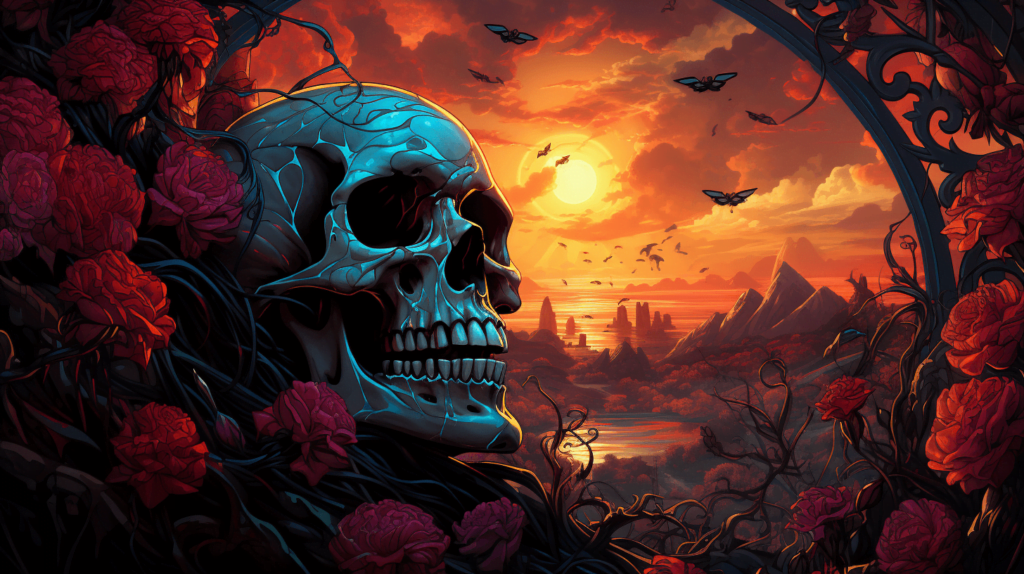
The mystery of what lies beyond death has fascinated and perplexed humanity for millennia. As a response to this enigma, cultures across the globe have woven intricate myths and narratives about death and the afterlife. These tales provide insights into how different societies perceive death, what they believe awaits us beyond this life, and how they grapple with the existential questions that mortality poses. This section offers a beginner’s exploration into the rich tapestry of myths about death and the afterlife.
Understanding Death Myths and Afterlife Beliefs
Myths about death and the afterlife are traditional narratives that attempt to explain what happens after we die. They often feature elements such as divine judgement, rewards and punishments, realms of the dead, spirits, and resurrection. These myths not only articulate beliefs about the afterlife, but also illuminate the living’s relationship with death, dying, and the deceased.
Common Features of Death and Afterlife Myths
Although death myths vary significantly across cultures, some common themes often emerge:
1. The Journey After Death: Many myths portray death as a journey or a transition rather than an end. The soul often travels through various realms, encountering challenges or trials along the way.
2. Divine Judgement: The notion of divine judgement after death is prevalent in many cultures. The deeds and morality of the individual during their life often determine their fate in the afterlife.
3. The Underworld or Afterlife Realms: Most cultures have myths that describe a realm or realms where the dead reside. These could be places of punishment or reward, rest or torment, depending on the individual’s actions in life.
4. Rebirth or Resurrection: Some myths articulate beliefs in reincarnation, the idea that the soul is reborn in a new body after death. Others feature resurrection, the concept of the dead rising again, often linked with eschatological beliefs.
Notable Death and Afterlife Myths
1. Egyptian Mythology: The ancient Egyptians held intricate beliefs about the afterlife, reflected in the myth of the weighing of the heart. Upon death, the individual’s heart was weighed against the feather of Ma’at, the goddess of truth. If balanced, the soul could enter the blissful Field of Reeds.
2. Greek Mythology: The Greeks believed in an underworld ruled by Hades, where the dead resided after life. The realm was divided into various sections, including Elysium for the heroic and virtuous, and Tartarus for the wicked.
3. Norse Mythology: Norse beliefs encompassed various afterlife realms, including Valhalla, where warriors slain in battle feasted and fought until the end of days, and Hel, a dreary realm for those who died of disease or old age.
4. Hinduism and Buddhism: Both traditions articulate beliefs in reincarnation and karma, where the actions of an individual in their life influence the circumstances of their next birth.
The Significance of Death and Afterlife Myths
Death and afterlife myths serve several essential functions in societies:
1. Confronting Mortality: These myths offer a framework for individuals to confront and make sense of the inevitability of death, often providing hope and consolation.
2. Moral Guidance: By linking afterlife consequences with earthly actions, these myths often underscore moral lessons and ethical codes.
3. Ritualistic Importance: Many death and afterlife beliefs inform rituals and practices related to death, such as funerals, ancestor worship, and commemorative festivals.
Conclusion
Myths about death and the afterlife provide a remarkable glimpse into humanity’s collective psyche, reflecting our deepest fears, hopes, and speculations about the mystery that lies beyond the veil of death. They not only offer comfort and guidance in the face of mortality, but also encapsulate the philosophical and ethical frameworks that underpin various cultures and civilizations. As we continue to explore these narratives, we gain invaluable insights into not just how different cultures perceive death, but also how they perceive life.
Trickster Myths
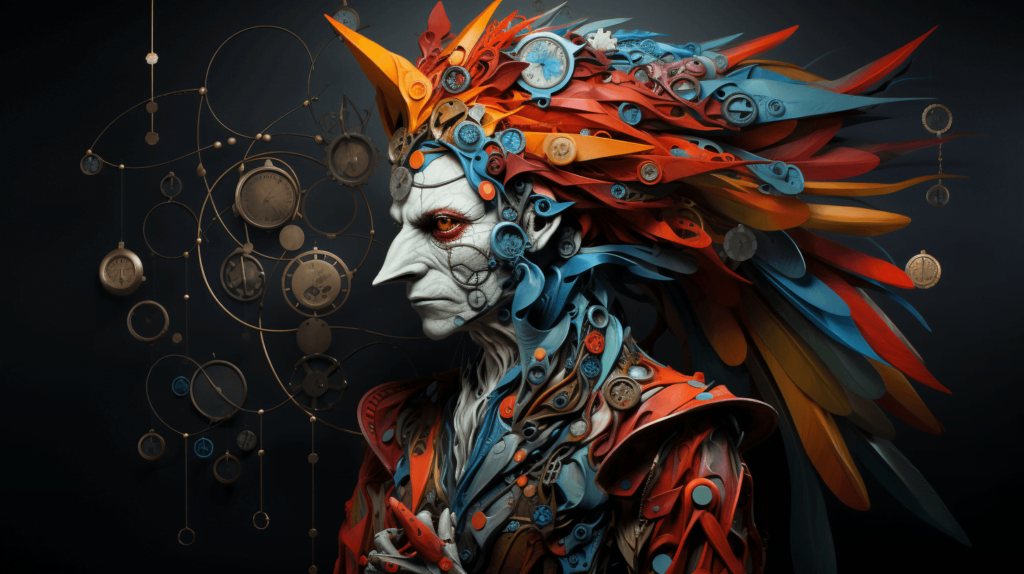
Trickster myths, a fascinating subset of global folklore and mythology, feature sly, cunning characters who disrupt the status quo through their mischief, cunning, or rebelliousness. Often boundary-crossers, tricksters can be creators, destroyers, heroes, or villains, and are frequently a source of humor and wisdom in these narratives. This section offers a beginner’s exploration into the captivating world of trickster myths, highlighting their characteristics, purpose, and most renowned figures.
Understanding Trickster Myths
Trickster myths revolve around a trickster, a character that uses intelligence, deceit, or practical jokes to challenge the rules and norms of society or nature. These figures often blur the lines between right and wrong, sacred and profane, mortal and divine, reflecting the complexity and paradoxes inherent in life.
Common Features of Trickster Myths
Despite their diverse representations across cultures, tricksters often share common traits:
1. Cunning and Deceit: Tricksters are often depicted as intelligent and cunning, using their wits to outsmart others.
2. Disruption and Rebellion: Tricksters tend to challenge norms, rules, and conventions, sometimes causing chaos and disruption.
3. Transformation: Many tricksters have the ability to shape-shift or transform, adding to their unpredictable and chaotic nature.
4. Humor: Trickster tales are often humorous, with the trickster’s antics leading to comic situations.
5. Ambiguity: Tricksters typically inhabit a moral gray area, and their actions can lead to both beneficial and harmful outcomes.
Notable Tricksters in Mythology
1. Anansi: This West African trickster, often depicted as a spider, is known for his intelligence and skill at manipulating others to his advantage.
2. Loki: In Norse mythology, Loki is a shape-shifting god known for his mischievous and chaotic behavior, often causing trouble among the gods.
3. Coyote: Featured in many Native American cultures, the Coyote is a prominent trickster figure who often plays the role of both creator and jester.
4. Hermes: In Greek mythology, Hermes, the messenger of the gods, is also a god of boundaries and transitions, known for his cunning and trickery.
The Significance of Trickster Myths
Trickster myths play several important roles in human culture:
1. Social and Moral Commentary: Tricksters often challenge societal norms and conventions, providing a critique or commentary on rules, behaviors, and morality.
2. Cultural Teaching Tools: These stories often serve as cautionary tales or morality lessons, illustrating the consequences of certain behaviors or actions.
3. Catalysts for Change: Tricksters often disrupt the status quo, leading to change, innovation, or transformation in the narrative.
4. Reflections of Human Nature: Tricksters, with their complexity and unpredictability, reflect the multifaceted nature of human character and the paradoxes of life.
Conclusion
Trickster myths, filled with mischief and wisdom, mirror the chaos and order, the folly and intelligence, and the creativity and destructiveness that define the human experience. By studying these narratives, we not only gain insights into diverse cultural worldviews but also explore the inherent complexity and ambiguity of our shared humanity.
Myths of Disasters and Cataclysms
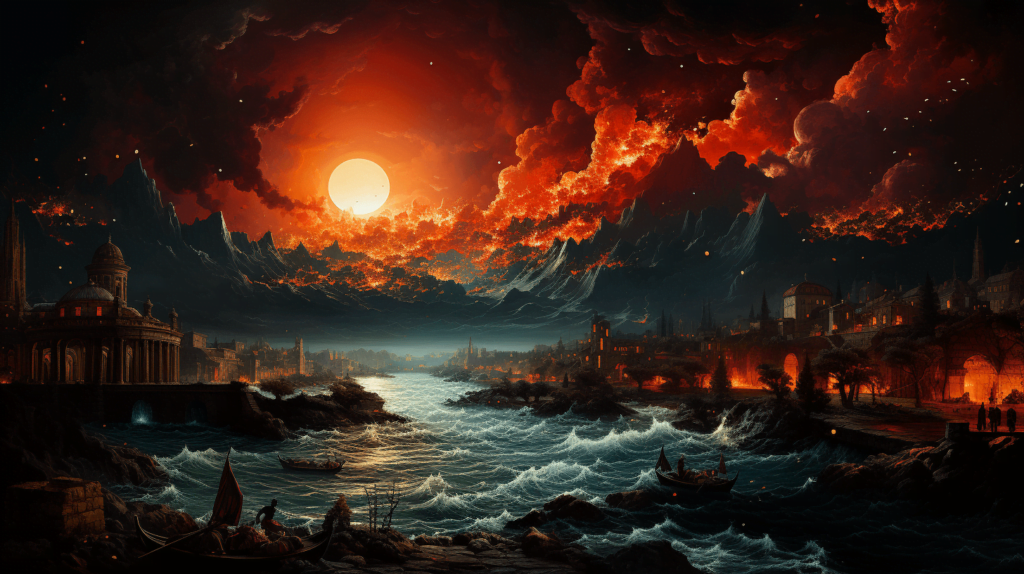
From the ancient world to modern times, myths of disasters and cataclysms have been woven into the tapestry of human storytelling. These narratives, often depicting large-scale destruction and calamity, seek to explain natural disasters and other catastrophic events that societies have faced. This section offers an introductory exploration of these disaster myths, illuminating their features, origins, and cultural significance.
Understanding Disaster and Cataclysm Myths
Disaster and cataclysm myths are traditional narratives that describe significant catastrophes often involving the destruction of the world or civilization. They frequently feature divine intervention or natural phenomena, such as floods, fires, earthquakes, or celestial disruptions, which bring about mass destruction and occasionally, subsequent rebirth.
Common Features of Disaster and Cataclysm Myths
While disaster myths vary widely across cultures, they often share common elements:
1. Divine Wrath or Punishment: Many disaster myths attribute the calamity to the wrath of a deity or deities, often in response to human transgressions or hubris.
2. Natural Disasters: These myths frequently involve large-scale natural disasters, such as floods, fires, or earthquakes, which result in widespread destruction.
3. Themes of Renewal or Rebirth: Despite their destructive themes, many of these myths also include elements of renewal, rebirth, or a new beginning following the disaster.
4. Heroes or Survivors: Often, these narratives feature a few survivors or heroes who manage to endure the catastrophe, sometimes with divine guidance, and play a crucial role in the post-disaster world.
Notable Disaster and Cataclysm Myths
1. The Great Flood: Flood myths are remarkably universal, appearing in numerous cultures worldwide. One of the most well-known is the biblical story of Noah’s Ark, where Noah is commanded by God to build an ark to survive a great flood sent as divine punishment.
2. Ragnarok: In Norse mythology, Ragnarok is the prophesied end of the world, featuring a series of catastrophic events, including a great battle resulting in the death of many major figures, including the gods Odin, Thor, and Loki.
3. The Destruction of Atlantis: The ancient Greeks told of a powerful civilization known as Atlantis, which fell out of favor with the gods and was swallowed by the sea.
4. The Tzitzimime: In Aztec mythology, the Tzitzimime were celestial beings associated with the stars who were believed to descend to earth and bring about darkness and destruction during solar eclipses.
The Significance of Disaster and Cataclysm Myths
Disaster and cataclysm myths serve several critical functions in human culture:
1. Explanation of Natural Phenomena: These myths offer explanations for natural disasters and catastrophic events, providing a framework for understanding these often terrifying phenomena.
2. Moral Lessons: By attributing disasters to divine wrath or punishment, these myths often convey moral and ethical lessons, emphasizing the consequences of actions that transgress societal or divine laws.
3. Catharsis and Comfort: By narrating the survival and renewal following disaster, these stories can provide hope and consolation in the face of destruction, emphasizing the resilience and endurance of life.
Conclusion
Myths of disasters and cataclysms reflect humanity’s enduring struggle to comprehend and cope with the unpredictable and destructive forces of nature. These narratives, while often haunting, ultimately underscore the resilience of life and the perennial potential for renewal amidst destruction. They serve as potent reminders of our fragility, our resilience, and our enduring quest to make sense of the world around us.
In tales spun on the loom of ages past,
Mythology, a mirror vast,
Reflecting echoes of the human soul,
In narratives both bright and ghast.
From creation’s spark to destruction’s toll,
In every culture, every scroll,
Universal themes, as stories unfold,
In myth’s great drama, we find our role.
Heroes rise, and tricksters play,
Divine hands mold our mortal clay.
Life’s mysteries, death’s unknown way,
In myth, these truths find their say.
The tapestry of tales untold,
Of love and hate, of young and old,
Of stories bold, in whispers sold,
In myth, life’s complexities take hold.
Threads of shared history we trace,
In the collective subconscious, find our place,
Exploring realms of time and space,
In myth, we seek meaning’s embrace.

